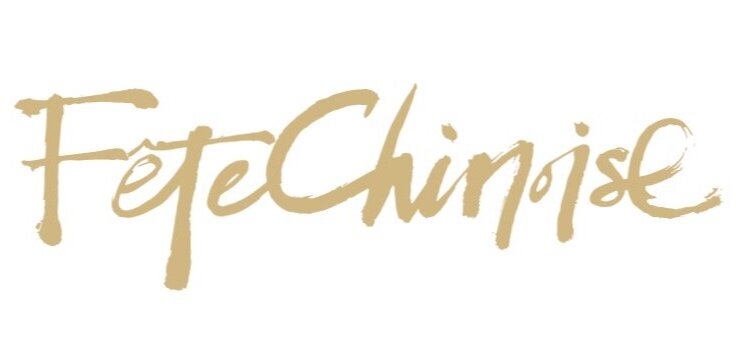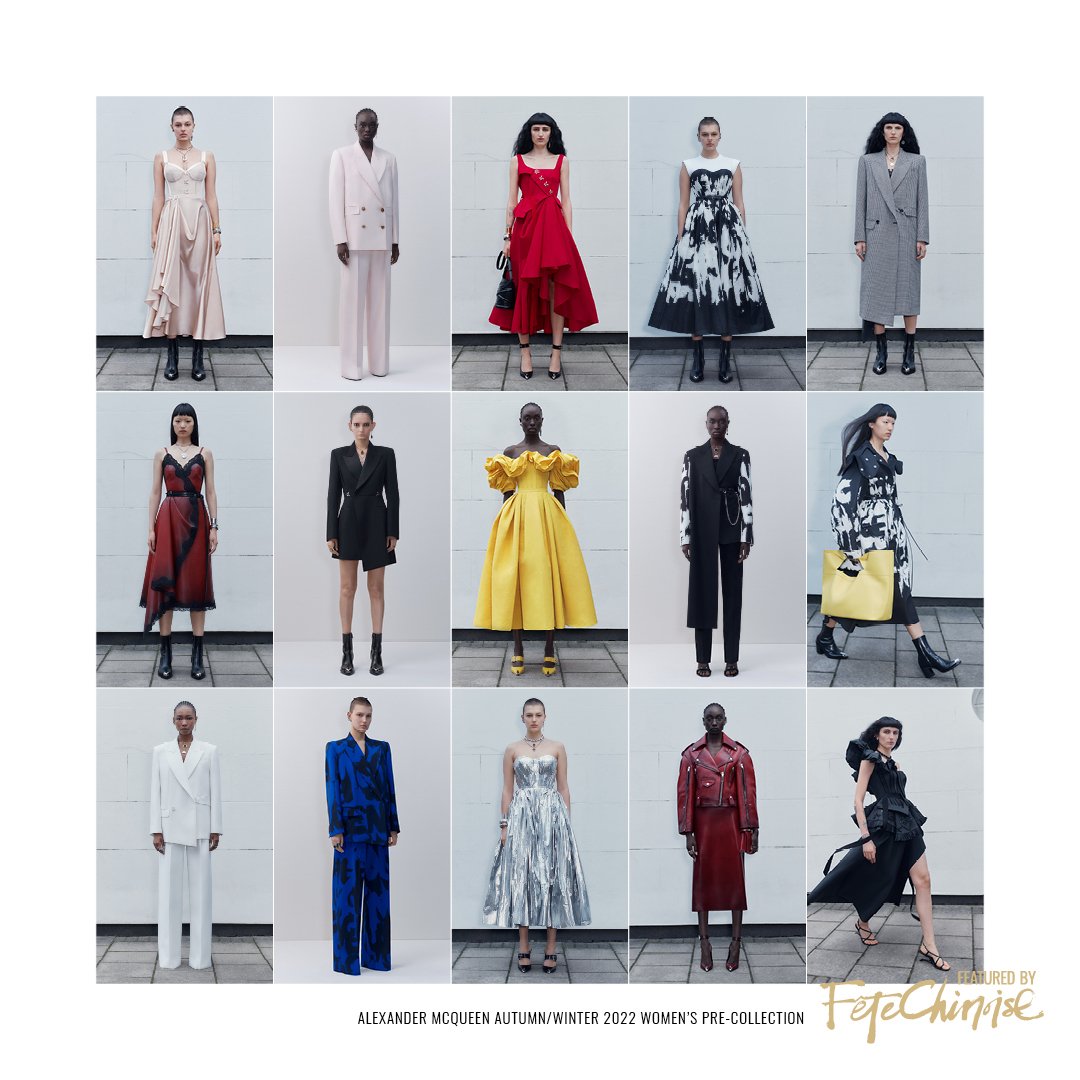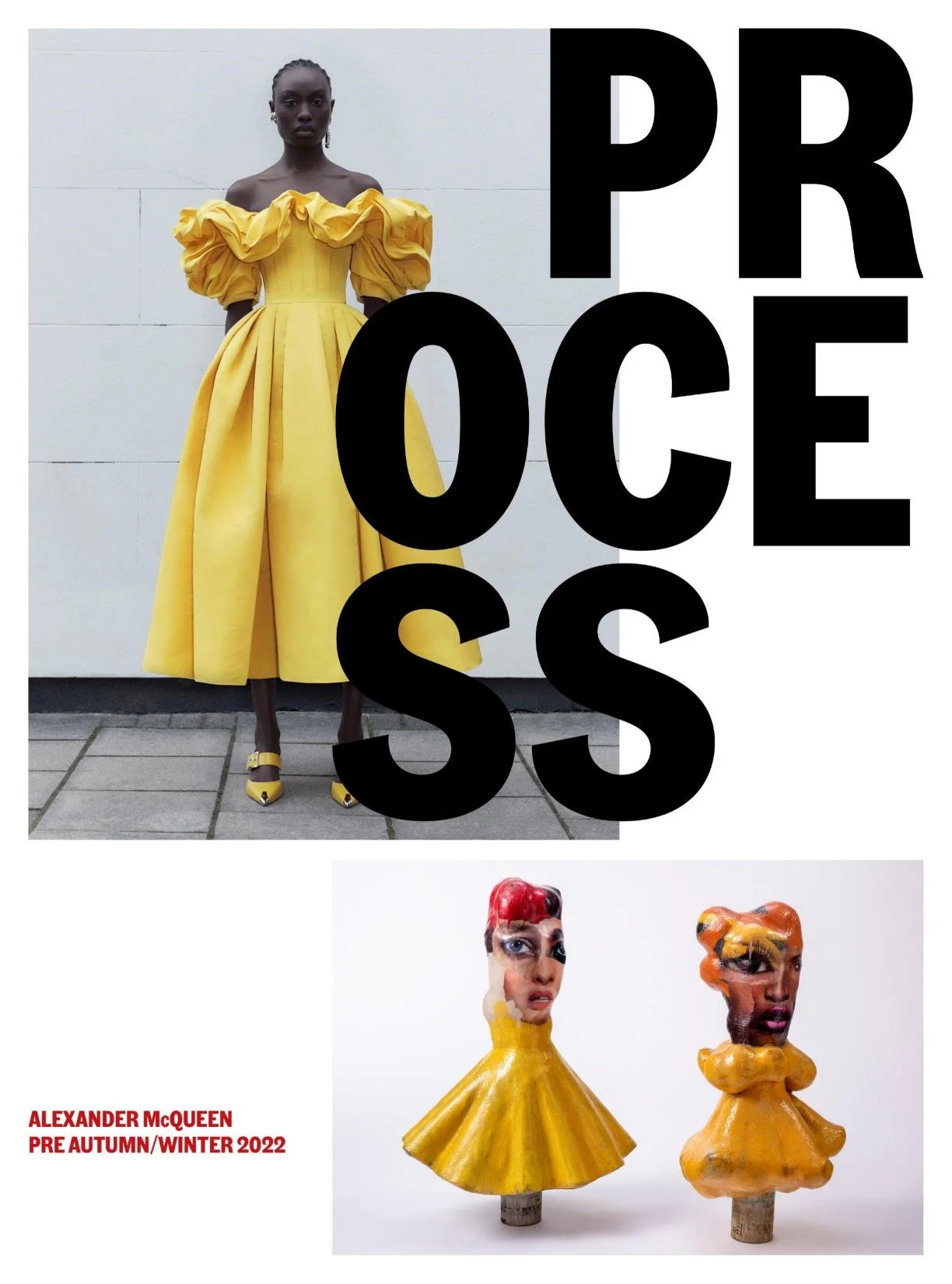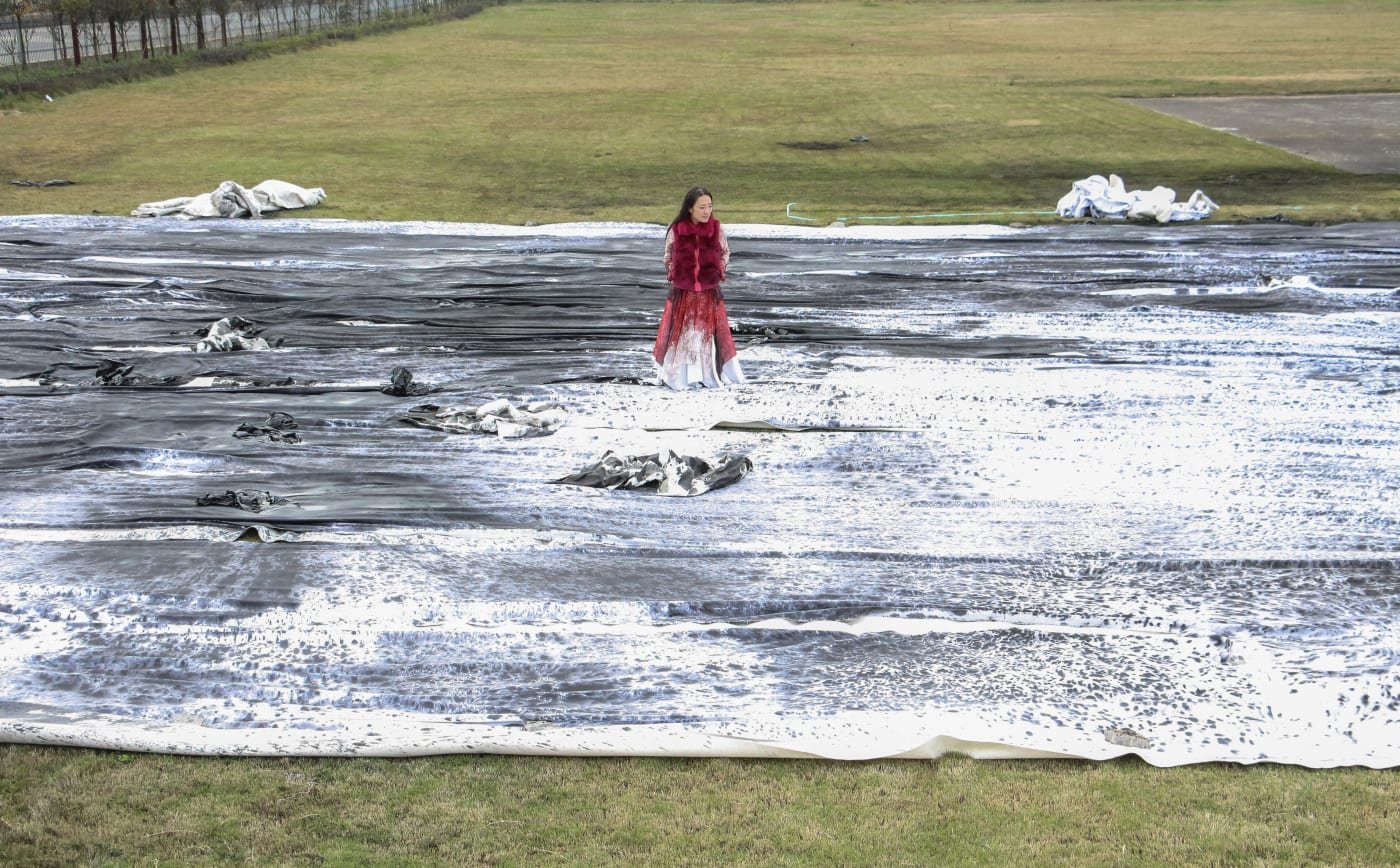Alexander McQueen: PROCESS + Pre-AW22 Womenswear Collection
Writing + Photo credits Alexander McQueen
Edited by the Fête Chinoise EDITORIAL Team
“I wanted to engage in a new creative dialogue with the collection this season and see how the artists interpreted the work that we created in the studio. It’s been very interesting to see how creativity has sprung from so many different perspectives, and the outcomes that have been varied and beautiful. We wanted the artists to have total freedom to respond to the looks, creating bold and thought-provoking conversations with their works. I hope that viewers will be as inspired as we have all been by witnessing these creative processes.”
– Sarah Burton, Creative Director.
alexander mcqueen autumn/winter 2022 pre-collection inspiration
Closer to the earth. Grounded. A focus on silhouette.
To illustrate the fact that creativity emerges from countless perspectives, Alexander McQueen invites a group of twelve artists to express their individual working practices inspired by the Autumn/Winter 2022 women’s pre-collection.
Each artist has chosen a look from the collection and responded to it through their preferred medium, engaging in a creative dialogue with the house. All have been given complete creative freedom resulting in a rich conversation between their work and the selected looks.
The artworks are conceived to be displayed alongside the McQueen pieces they relate to in a temporary installation at 27 Old Bond Street, our London flagship, designed to showcase the individual approaches and the ways in which artworks and looks interact.
Artists who are invited to participate include Ann Cathrin November Høibo, Beverly Semmes, Bingyi, Cristina de Middel, Guinevere van Seenus, Hope Gangloff, Marcia Kure, Jackie Nickerson, Jennie Jieun Lee, Judas Companion, Marcela Correa and Marcia Michael.
artist highlight
BINGYI 冰逸
Bingyi Based in Beijing, China. She created a wedding dress made from layers of the waterfall fabric and suit for groom. Artworks to be attached to dress and suit in London.The Wedding Dress that Takes OFF Itself: Using the material and process taken from her magnificent Emei Waterfall project, Bingyi designs the Wedding Dress to be a waterfall that flows off from a woman's body. The design has a strong conceptual power: as the model/bride walks down the isle, the dress will fall off her body into pieces. At the very end before she reaches the altar, she is stripped down to only wear the "underwear" dress.
The meaning of this performance of the dress has two layers: On the wedding day, the ritual is performed to show that it begins with a magnificent nature but ends with the power of human body. However, throughout the marriage, the man and woman begin with a ritual and in the end they have nothing but themselves for each other. The man’s is printed with a note of love. He is portrayed as a ‘wailing love letter’. This wedding is a union of nature and human, and also a union of painting and calligraphy.”
《悬置》Epoché | 布面油墨 Oil and ink on canvas | 2500 x 2500cm | 2014
深圳机场项目现场创作图片 Performance at Shenzhen Airport
Bingyi is perhaps best known for her large-scale ink paintings in which she collaborates, over months or years, with the environmental conditions of a specific site to capture a reality-scaled record of the climatic and topological forces shaping a natural or urban landscape. At the other end of her wide-ranging practice, Bingyi explores the microscopic origins of organic life in intimate, small-format paintings, in which her minute and meticulous brushwork paradoxically reveals a profoundly creative, gestural, and “calligraphically expressive” quality drawn from her daily calligraphy routine. Through her hypnotic, obsessive endurance and execution both painstaking and nuanced, one senses the loving power of nature itself as it crafts animate life from inanimate matter.
artist highlight
JENNIE JIEUN LEE
Jennie Jieun Lee is an artist based in New York state, USA. She is known for richly textured ceramics covered in abstract paintings and an array of objects including wheel-thrown, hand-altered vessels, masks and slip cast busts with morphing and multipart features that mimic, articulate and navigate emotional and psychological spaces.
“In developing my ceramic sculpture piece for the 2022 Alexander McQueen special project based on a chosenlook from the Autumn/Winter 2022 women’s pre-collection, I brought the method of initially throwingseveral vessels on the wheel, combining them together to make a tall vessel in the wet stage and then, post the initial bisque, firing- glazing the surfaces as if to imitate the arresting red leather dress worn by the model Wang in the look book provided to me. With clay, I added my interpretation of the sterling four-ring attached to the classic red leather clutch to the top and sides of the piece of the vessel, finishingit with a reflective palladium glaze. Combining the intoxicating features of the leather dress which is steepedin hues of dyed reds to deep burgundy, along with the metallic aspects of the ring onto the body of the ceramic work, I hope to invoke the emotions felt by the woman who gets to wear this chosen garment in her life’s moments.”
artist highlight
MARCIA KURE
Marcia Kure is a mixed media artist and sculptor based in Princeton, New Jersey, USA,
and Abuja and Kaduna, Nigeria.
“The body is a communication device. The script, text, and graffiti on the embroidered
garment recall Vai (Liberia), Bamun (Cameroon), Nsibidi and Uli script and body painting of southeastern Nigeria. These lines, glyphs, pictographs and scripts, transform and morph into mapping and trading systems that link naturally derived pigments to bodies, migration, labour, trade, and capital. The lines merge century-old trading systems - between Africa, Europe,and America -with modern day ones, collapsing time and space, fusing histories, and systems of power and production that in turn - become body, an abstracted body - a portrait of Queen Amina (1533-1610), the warrior ruler of the Hausa State of Zazzau.
The Amina Project includes one large scale drawing ‘Amina’; eighteen sculptures of relics, fragmentsand artifacts that represent death, carnage and spoils of war in the form of hair fascinators and four small scale drawings of imaginary members of Queen Amina’s court.”
artist highlight
ANN CATHRIN NOVEMBER HOIBO
Ann Cathrin November Høibo is an artist and sculptor based in Kristiansand, Norway.
Her background is in weaving and she also has an extensive sculptural practice that includes constructing the fixtures for her textiles.
“I chose all the pink and red looks from the collection. I wanted to make a warm and very
feminine environment in my studio, and try to translate that feeling into the work. I never make any sketches for my tapestries. They are based more on my shifting moods and drifting thoughts, from day to day. A bit like getting dressed.
Weaving is a slow process. I try to adapt and to be flexible, and not be too controlling with the different fabrics, as I blend them with the wool I normally use in my work.
With so much masculine pressure going on in the world, it's important to keep the heart soft. The Alexander McQueen looks inspire me in that way, the gentle and feminine inside with a harder cover for protection. Hold hodet kaldt og hjerte varmt, as I like to say in Norwegian.”
artist highlight
MARCELA CORREA
Marcela Correa is an artist and sculptor based in Chile.
“This work is born as a result of a solo development making a series of small models built as three-dimensional collages based on glued paper, magazine clippings, epoxy resin and fiberglass. It began in the midst of the pandemic, and perhaps for this reason it is about absent faces and broken memories. The work takes a long time to execute, placing successive material layers where each one of them provides new information, gives more life. It is my first three-dimensional pictorial work so it is maybe the beginning of a new stage. The materials interest me as a field of research and not as formal results. This exercise, especially thanks to the intensive use of colour as a three-dimensional material, opens new doors, new research.”















Every special moment deserves a look that feels effortless, stylish, and a little unforgettable. From sun-drenched garden parties to sparkling evening soirées, this chapter brings you curated outfits, accessories, and styling tips to help you shine with confidence. Think romantic florals, bold statement pieces, and modern twists on classic elegance: each look designed to celebrate the occasion, the season, and, most importantly, your own unique style.